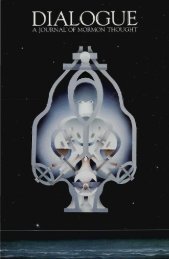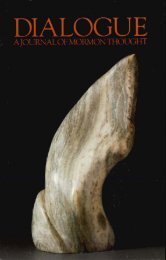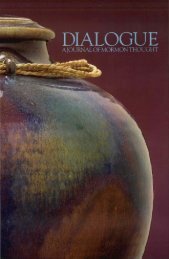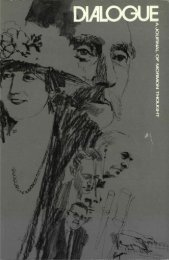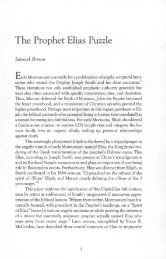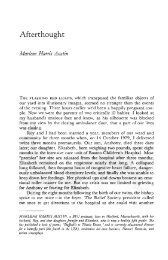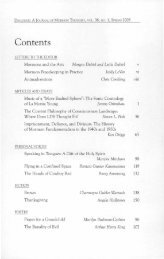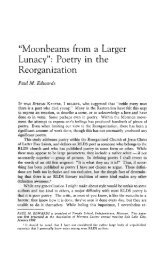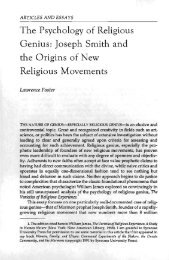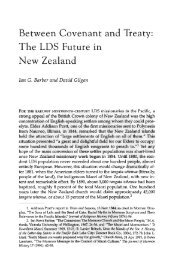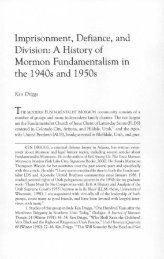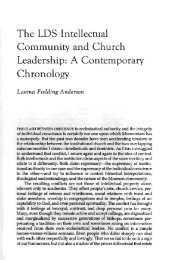Dialogue, Volume 25, Number 2 - Dialogue – A Journal of Mormon ...
Dialogue, Volume 25, Number 2 - Dialogue – A Journal of Mormon ...
Dialogue, Volume 25, Number 2 - Dialogue – A Journal of Mormon ...
You also want an ePaper? Increase the reach of your titles
YUMPU automatically turns print PDFs into web optimized ePapers that Google loves.
26 DIALOGUE: A JOURNAL OF MORMON THOUGHT<br />
enthusiastic. Not that prosperity itself was bad; but the Saints seemed<br />
unable to maintain spirituality in the face <strong>of</strong> increasing prosperity.<br />
Like egg-sucking foxes, avaricious members seemed to have left a<br />
material shell drained <strong>of</strong> spiritual substance. Summing up the feelings<br />
<strong>of</strong> a number <strong>of</strong> the Presidency and the Quorum <strong>of</strong> the Twelve, Brigham<br />
Young said that many members thought only about "how they can get<br />
this House built or a farm, Horses cattle &c. Their whole soul," Young<br />
opined, "is in the work <strong>of</strong> the world not the building <strong>of</strong> the kingdom <strong>of</strong><br />
God." In commenting on this tendency, Young warned: "Any man<br />
that gets property upon this principle it will Carode him" (in Woodruff<br />
1983-85, 4:506).<br />
During the early 1850s, Church leaders, with no apparent dissent,<br />
concluded that the Church needed a "Reformation" (Kimball 1981,<br />
207-8). In 1855 they proposed structural reforms in the organization<br />
<strong>of</strong> congregations to try to reinfuse the temporal shell with spiritual<br />
substance. At the October 1855 general conference, President Young<br />
outlined a system <strong>of</strong> home missions. In contrast to traditional proselytizing<br />
work, these missions were designed to reactivate the Church<br />
members in Zion rather than to convert Gentiles.<br />
On 6 October, President Young called Orson Pratt, Parley P. Pratt,<br />
and Wilford Woodruff from the Quorum <strong>of</strong> the Twelve to supervise<br />
the program, and several lay members assisted them. Following President<br />
Young's instructions, on 15 October these men, together with<br />
George A. Smith and Erastus Snow, both <strong>of</strong> whom had been called on<br />
foreign missions, met to divide Utah into six missionary districts and<br />
to appoint home missionaries — usually members <strong>of</strong> teachers quorums —<br />
to serve in each district (Woodruff 1983-85, 4:338-39). Local Church<br />
members labored as missionaries in the various wards and communities<br />
while the Twelve functioned as traveling supervisors, conducting<br />
quarterly conferences in each stake and reporting to the First Presidency<br />
and the Twelve on the spiritual condition <strong>of</strong> the Saints. Working<br />
with the local missionaries, the Twelve preached, exhorted, held Church<br />
courts in difficult cases, and tried to instill obedience and commitment<br />
in the minds <strong>of</strong> the people. One <strong>of</strong> the leaders in this reform movement,<br />
Wilford Woodruff, began his first assignment on 19 October<br />
1855 when he accompanied Thomas Kington to a quarterly conference<br />
in Farmington (Woodruff 1983-85, 4:339). Through the fall and<br />
winter <strong>of</strong> 1855, Woodruff visited Ogden, Tooele, Provo, and Bountiful,<br />
usually accompanied by Orson Pratt and Parley P. Pratt (Woodruff<br />
1983-85, 4:339, 353-59).<br />
In establishing this supervisory process for the home missions,<br />
Church leaders broke with the tradition <strong>of</strong> congregational autonomy<br />
that had grown during the eight years settlements had spread into out-



